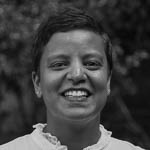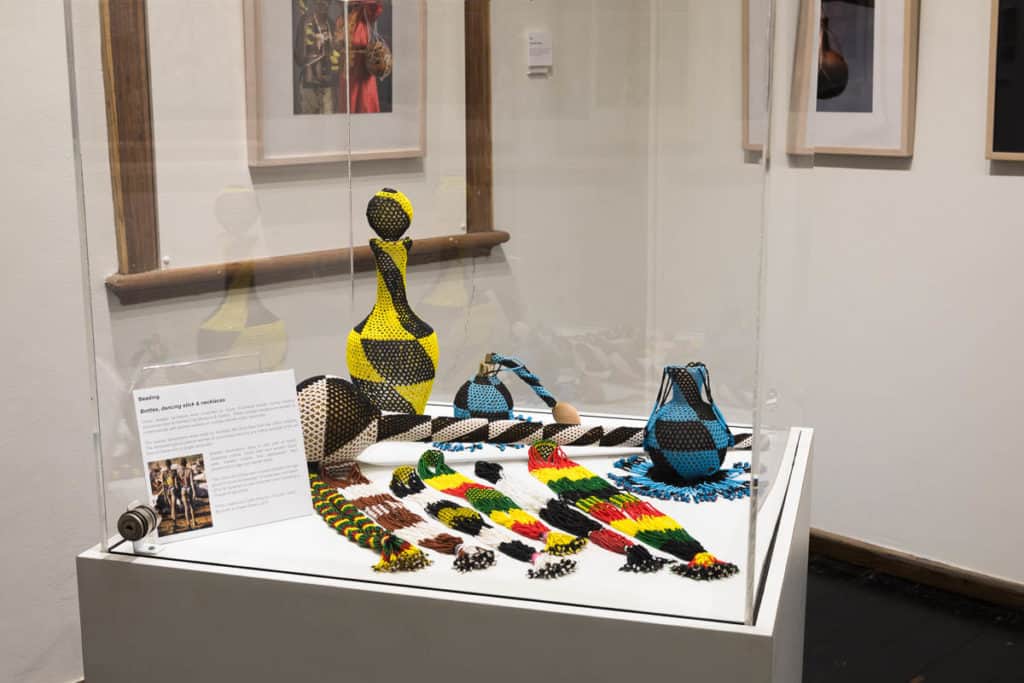- Showcasing Elders’ skills
- The necklace I received as a present
- The exhibition space
Clusters of coloured beads are spread out on a trestle table in a repurposed machinery shed in Fairfield. A group of women, thread and needle in hand, chat loudly in Dinka while they make necklaces and earrings. It’s Saturday and I’m spending time with South Sudanese women at the Fairfield City Museum and Gallery to find out how art helps them adapt to their new home in Western Sydney. We meet over several weeks for a few hours to share lunch and enjoy creative workshops.
The women live locally but they haven’t been to this community-art gallery or participated in public activities before. The curators and myself, an academic who does some bricolage in arts-based research, have offered to organise regular gatherings just for South Sudanese women so that they can come together to practise cultural and artistic activities. They choose to cook dishes from their home country, make jewellery and traditional dance costumes, braid hair, dance, sing…
The women lead the way. They decide what to do for each workshop and get organised among themselves to buy ingredients and supplies. No need for an external facilitator, they tell us. They have all the expertise they need in the room. The Elders bring a wealth of artistic and cultural knowledge that they are keen to pass on to younger generations, for whom some of this is somewhat new.
Their jewellery making involves patiently threading small plastic beads into specific coloured patterns. The Elders are nimble. The younger women have never tried this before. The beading activity takes more than the week we’d set aside for it, as it’s quite tricky for some. There is laughter as some women create exquisite patterns, while others (including me) give up in frustration. One woman says that beading is akin to meditation as they have to focus and be quiet, but another admits she finds it boring. The women who persevere wear their matching necklace and earrings with pride the following week.
This women-only space provides sanctuary for candid conversations about art, gender norms, cultural traditions, memories, and problems. The younger women say that they wouldn’t usually question the Elders about customs they don’t quite understand, but in these workshops, it feels safe to do so. Their enthusiasm to come together to share cultural and artistic activities gives the Elders a chance to share what they can do and what they know with the younger generation. For a moment, the women forget about their day-to-day worries.
They quickly welcomed me into the group. I am a migrant and I’ve lived in Australia for 13 years. But I can never claim to understand what it’s like to be forced to leave my country, to run for my life, be scared for my family’s safety, to live in exile, then be sent to a new country to “rebuild”. I am a privileged academic who researches refugee issues and have access to resources and opportunities. Many things separate us, but many also connect us. Like the South Sudanese women, I am juggling multiple cultures in a white-majority, English-speaking country. We enjoy what this adopted country has to offer, but also struggle with many of its norms.
I feel happiest when I’m with this group of lively, generous women, listening to their stories. Our conversations around life in South Sudan, life in Sydney, women’s roles, are precious moments of storytelling. Yes, it is my role as researcher to attend and observe, but something else is happening in this space that has nothing to do with me. Amid the complications of everyday life with imposed measurements of “success”, the South Sudanese women own this space. They are the holders of knowledge. They express themselves confidently, and I’m the one who is walking with uncertainty in these new surrounds. But that’s perfectly fine. I unlearn what I think I know about these women, their stories, and their everyday realities, and re-learn as they lead me along an unexplored path using art. They transform the art gallery with their singing, their colours, their children’s laughter.
The Elder who has used the beading technique countless times before has offered to teach others. When we first meet, it’s hard to exchange more than formal greetings, as I’m unsure whether we needed to communicate via an interpreter. But our smiles convey a feeling of mutual respect. Soon, she is sharing memories of years of beading to create jewellery and decorative objects. She is also a songwriter, so every piece of jewellery, every object has a story. She is proud that her skills are valued in a country where it is made difficult to “fit in the box” of what a “successful” refugee should be.
The Elder offers me a necklace. Its red, black and white segments echo the colours of the South Sudanese flag. Through this gesture, she is letting me in. No words needed. She is inviting me to learn more about the things that are important to her and her community. She is signalling to others that I’m OK, and I can sit with them while they share stories about art and life.
Weeks later, we hold a community event at the gallery to showcase the women’s artefacts and creations to the public, alongside their stunning portraits taken by a professional photographer. I wear the necklace (with a matching red, black and white dress!) and the Elder is pleased. We’ve come full circle. Our very different pathways have brought us together in this unique space. We may not have met in any other context but the art gallery was a place of welcome and exchange about art and human connection.
Our aim as organisers was to create a welcoming space for the women and their children, but it was in fact them who welcomed us into their circle.
This experience haunts me. Our conversations while we partake in artistic activities remind me of some of the difficulties that newcomers have to overcome during those first few years to meet the new country’s expectations. I hear snippets of a life-long process of figuring out what parts of their existing identity they should keep, challenge, or reinvent. Women’s difficulties, especially those who are single, are not always discussed openly, and initiatives like these creative workshops might be the only space where they get to talk freely and candidly.
Listening to the women also reminds me that, like most of the people from refugee and asylum seeker backgrounds I’ve met over the past ten years, they never dwell for too long on hardships or feel sorry for themselves. They are hopeful, motivated, and appreciate what they have. Women especially enjoy the sanctuary created by artistic activities to think about their past, share opinions about the present, and consider the future with all its possibilities.
Further reading
Caroline Lenette, Apuk Maror & Serena Manwaring (forthcoming) Mothers & Daughters: Redefining cultural continuity through South Sudanese women’s artistic practices.
Caroline Lenette and colleagues (2018). ‘Better than a pill’: Digital storytelling as a narrative process for refugee women. Media Practice and Education. Online 22 May 2018.
Caroline Lenette (2015). Mistrust and refugee women who are lone parents in resettlement contexts. Qualitative Social Work 14(1), 119-134.
Author
 Caroline Lenette is an arts-based researcher in refugee studies at the University of New South Wales in Sydney. She collaborates with people from refugee and asylum seeker backgrounds, especially women, to explore their experiences of settlement using creative methods like digital storytelling and participatory video. Her book, Sanctuary: Arts-based methods in refugee research, will be published with Springer in 2019.
Caroline Lenette is an arts-based researcher in refugee studies at the University of New South Wales in Sydney. She collaborates with people from refugee and asylum seeker backgrounds, especially women, to explore their experiences of settlement using creative methods like digital storytelling and participatory video. Her book, Sanctuary: Arts-based methods in refugee research, will be published with Springer in 2019.





Comments
what a lovely description of life being inspired and nurtured by art – the gathering of collectables including the welcoming of newcomers to this delicate process while creating colourful and lasting connections – the role reversals in which the organisers relinquish and unlearn in order to learn something new. There is a magic about this.